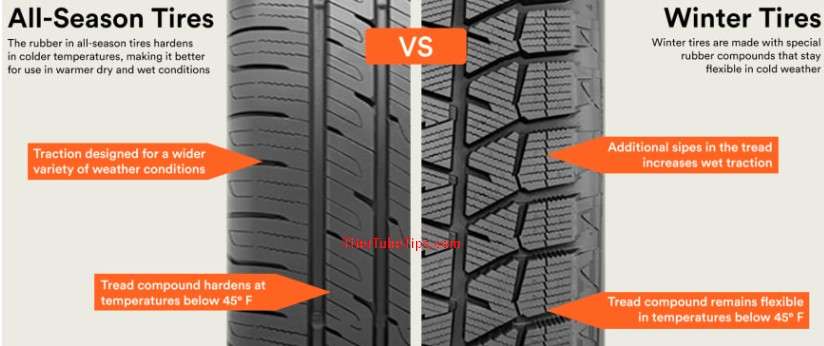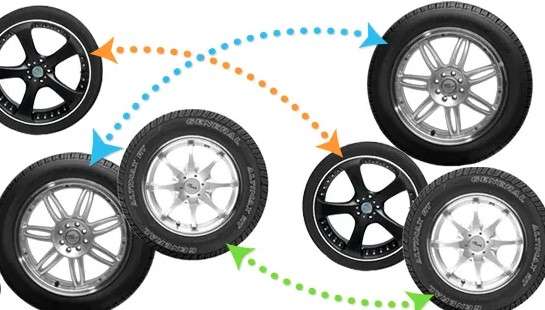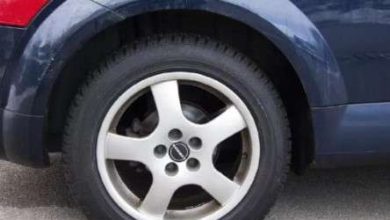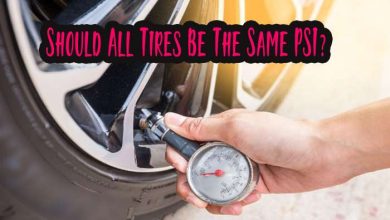Can I Put Snow Tires On Front Only? Using 2 Winter Tires
Winter is just around the corner, and for many of us, that means it’s time to start thinking about our tires. Regular tires may not cut snow and ice. That’s where snow tires come into play.
In this blog post, I will explain everything you need to know about snow tires, including the burning question – can I put snow tires on the front only?
What are snow tires, and how do they differ from regular tires?
Snow tires, also known as winter tires, are specially designed to excel in cold and snowy conditions. They feature a unique tread pattern and rubber compound, providing better traction on slippery surfaces.

In contrast, regular tires, known as all-season tires, are designed for year-round use and may not perform well in extreme winter weather. Read Also: Are 20 Inch Tires Good In The Snow?
All-Wheel Drive vs. Two-Wheel Drive Vehicles
Regarding the debate about snow tires, the type of vehicle you drive plays a significant role. All-wheel drive (AWD) vehicles have power going to all four wheels, offering improved traction in various conditions.
On the other hand, two-wheel drive (2WD) vehicles, like your average sedan, only have power going to either the front or rear wheels.
Can I put snow tires on front only?
No, you should not put snow tires on the front only. It is not safe.
Snow tires are designed to provide better traction on snow and ice than all-season tires. When you only put snow tires on the front, the front wheels will have better traction than the rear wheels. This can lead to oversteering, when the front wheels turn more than the rear wheels, and the car spins out of control.

Even if you are driving a front-wheel drive car, having snow tires on all four wheels is still important. This will help to ensure that your car has equal traction on all four corners and is less likely to lose control.
Here are some of the specific risks of putting snow tires on the front only:
- Increased risk of oversteering: The car is more likely to oversteer when the front wheels have better traction than the rear wheels. This can happen when you are braking, accelerating, or turning.
- Reduced braking performance: Snow tires on the front will not provide as much braking traction as snow tires on all four wheels. This can make stopping your car safely in slippery conditions more difficult.
- Reduced handling stability: Snow front tires can make your car less stable in corners. This can increase the risk of hydroplaning or losing control of your vehicle.
If you live in an area that gets a lot of snow, it is important to have snow tires on all four wheels. This will help to keep you safe and prevent accidents.
Putting them on the rear wheels is better if you can only afford to buy two snow tires. This will help improve your car’s handling stability and reduce the risk of oversteering.
The Importance of Matching Tires
Consistency is key during the winter season. Matching tires means having the same type of tire on all four wheels of your vehicle. Here’s why it’s so crucial:
1. Balanced Performance
Think of your tires as a team working together to keep you safe on the road. All four tires can deliver a balanced and coordinated performance when they match. This balance translates to consistent traction and handling, essential in slippery winter conditions.
2. Predictable Handling

Predictability is vital when driving in snow or on icy roads. When your tires match, your vehicle’s behavior is more consistent. You’ll know how your car will respond when accelerating, braking, or steering. This predictability can be a lifesaver when you encounter unexpected situations on the road.
3. Improved Braking
Winter driving often involves sudden stops, and your ability to brake effectively is critical. Matching tires ensures your vehicle can come to a halt with greater ease and control. Different tire types can lead to uneven braking performance, potentially causing accidents.
4. Enhanced Traction
Traction is your best friend in winter. It’s what keeps your vehicle glued to the road, allowing you to move forward without slipping and sliding. Matching snow tires provide consistent traction, reducing the risk of skidding, spin-outs, or getting stuck in the snow.
5. Safer Cornering
Whether navigating a gentle curve or making a sharp turn, matched tires make cornering safer. They help distribute the forces evenly so your car remains stable and doesn’t skid or lose control during turns.
6. Snow Tire Efficiency
When you invest in snow tires, you want to get the most out of them. Using them on all four wheels ensures you enjoy the full benefits of these specialized winter performers.
Mixing them with regular tires can diminish their effectiveness, making them less suitable for dealing with snow and ice. Read My recent post- Are Low Profile Tires Good in Snow?
The Four-Wheel Drive Dilemma
You might wonder, “Do I still need snow tires if I have a four-wheel drive (4WD) vehicle?” While 4WD can provide improved traction, it’s essential to remember that it doesn’t make your vehicle invincible on snowy roads. Snow tires are still highly recommended.
4WD systems primarily assist with acceleration, meaning they help you get moving. However, they don’t provide any extra help regarding braking or steering. This is where snow tires come into play, enhancing your vehicle’s ability to stop and maneuver safely in icy conditions.
To ensure your safety and optimize your vehicle’s winter performance, equip your 4WD vehicle with full snow tires.
Frequently Asked Questions (FAQs)
Can I mix snow tires with regular tires on my vehicle?
Mixing snow tires with regular tires is not recommended. It can lead to unpredictable handling and reduce the effectiveness of your snow tires. It’s best to use a complete set of snow tires during winter.
Do I need to replace all four tires with snow tires?
Ideally, yes. To maintain proper handling and safety, replacing all four tires with snow tires is advisable. Mixing snow tires with regular tires can compromise performance.
Is it safe to use snow tires on only one set of wheels?
No, using snow tires on only one set of wheels is unsafe. This can create handling imbalances and reduce your vehicle’s overall stability, especially during braking and steering.
What are the signs that my snow tires need replacement?
Monitor your snow tires for signs of wear, including reduced tread depth and visible damage. If you notice these issues, it’s time to replace your snow tires to ensure optimal performance in winter conditions.
Should I put snow tires on the front or back?
For optimal safety and control, installing snow tires on all four wheels of your vehicle is recommended. This ensures balanced handling and traction, reducing the risk of accidents on slippery winter roads.
Conclusion
So, there you have it, folks! The verdict is clear: you should not only put snow tires on the front. A safety risk can lead to unpredictable handling and compromised stability.
To fully embrace the winter season and ensure your safety on the road, equip all four wheels of your vehicle with quality snow tires.
Source
https://www.tirerack.com/upgrade-garage/how-do-i-select-the-right-size-winter-snow-tires




